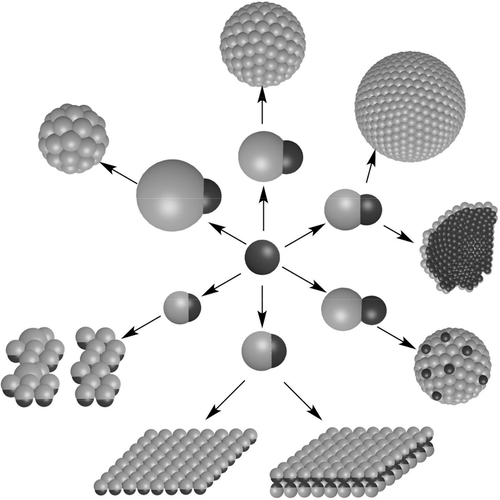Our official English website, www.x-mol.net, welcomes your
feedback! (Note: you will need to create a separate account there.)
Influence of Geometries on the Assembly of Snowman-Shaped Janus Nanoparticles
ACS Nano ( IF 15.8 ) Pub Date : 2018-03-07 00:00:00 , DOI: 10.1021/acsnano.8b00960 Chengjun Kang 1 , Andrei Honciuc 1
ACS Nano ( IF 15.8 ) Pub Date : 2018-03-07 00:00:00 , DOI: 10.1021/acsnano.8b00960 Chengjun Kang 1 , Andrei Honciuc 1
Affiliation

|
The self-assembly of micro/nanoparticles into suprastructures is a promising way to develop reconfigurable materials and to gain insights into the fundamental question of how matter organizes itself. The geometry of particles, especially those deviating from perfectly spherical shapes, is of significant importance in colloidal assembly because it influences the particle “recognition”, determines the particle packing, and ultimately dictates the formation of assembled suprastructures. In order to organize particles into desired structures, it is of vital importance to understand the relationship between the shape of the colloidal building blocks and the assembled suprastructures. This fundamental issue is an enduring topic in the assembly of molecular surfactants, but it remained elusive in colloidal assembly. To address this issue, we use snowman-shaped Janus nanoparticles (JNPs) as a model to systematically study the effect of colloidal geometries on their assembled suprastructures. Ten types of JNPs with identical chemical compositions but with different geometries were synthesized. Specifically, the synthesized JNPs differ in their lobe size ratios, phase separation degrees, and overall sizes. We show that by altering these parameters, both finite suprastructures, such as capsules with different curvatures, and nonfinite suprastructures, including free-standing single-layered or double-layered JNPs sheets, can be obtained via self-assembly. All these different types of suprastructures are constituted by highly oriented and hexagonally packed JNPs. These findings demonstrate the significance of geometries in colloidal assembly, such that slightly changing the building block geometries could result in a large variety of very different assembled structures, without altering the chemistry of the particles.
中文翻译:

几何形状对雪人形Janus纳米粒子组装的影响。
微米/纳米粒子自组装成超结构是开发可重构材料并深入了解物质如何组织自身这一基本问题的有前途的方法。粒子的几何形状,特别是那些偏离完美球形的几何形状,在胶体组装中非常重要,因为它会影响粒子的“识别”,确定粒子的堆积并最终决定组装的超结构的形成。为了将颗粒组织成所需的结构,了解胶体结构块的形状与组装的超结构之间的关系至关重要。这个基本问题在分子表面活性剂的组装中是一个持久的话题,但在胶体组装中仍然难以捉摸。为了解决这个问题,我们使用雪人形状的Janus纳米颗粒(JNPs)作为模型来系统地研究胶体几何形状对其组装的超结构的影响。合成了十种类型的JNP,它们具有相同的化学组成但具有不同的几何形状。具体地说,合成的JNP在其波瓣尺寸比,相分离度和总体尺寸上有所不同。我们表明,通过更改这些参数,可以获得有限的超结构(例如具有不同曲率的胶囊)和非有限的超结构,包括独立的单层或双层JNP片材。具体地,合成的JNP在它们的波瓣尺寸比,相分离度和整体尺寸方面不同。我们表明,通过更改这些参数,可以获得有限的超结构(例如具有不同曲率的胶囊)和非有限的超结构,包括独立的单层或双层JNP片材。具体地说,合成的JNP在其波瓣尺寸比,相分离度和总体尺寸上有所不同。我们表明,通过更改这些参数,可以获得有限的超结构(例如具有不同曲率的胶囊)和非有限的超结构,包括独立的单层或双层JNP片材。通过自组装。所有这些不同类型的超结构均由高度取向的六角形堆积的JNP构成。这些发现证明了几何形状在胶体组装中的重要性,因此,稍微改变构件的几何形状可以导致各种各样非常不同的组装结构,而不会改变粒子的化学性质。
更新日期:2018-03-07
中文翻译:

几何形状对雪人形Janus纳米粒子组装的影响。
微米/纳米粒子自组装成超结构是开发可重构材料并深入了解物质如何组织自身这一基本问题的有前途的方法。粒子的几何形状,特别是那些偏离完美球形的几何形状,在胶体组装中非常重要,因为它会影响粒子的“识别”,确定粒子的堆积并最终决定组装的超结构的形成。为了将颗粒组织成所需的结构,了解胶体结构块的形状与组装的超结构之间的关系至关重要。这个基本问题在分子表面活性剂的组装中是一个持久的话题,但在胶体组装中仍然难以捉摸。为了解决这个问题,我们使用雪人形状的Janus纳米颗粒(JNPs)作为模型来系统地研究胶体几何形状对其组装的超结构的影响。合成了十种类型的JNP,它们具有相同的化学组成但具有不同的几何形状。具体地说,合成的JNP在其波瓣尺寸比,相分离度和总体尺寸上有所不同。我们表明,通过更改这些参数,可以获得有限的超结构(例如具有不同曲率的胶囊)和非有限的超结构,包括独立的单层或双层JNP片材。具体地,合成的JNP在它们的波瓣尺寸比,相分离度和整体尺寸方面不同。我们表明,通过更改这些参数,可以获得有限的超结构(例如具有不同曲率的胶囊)和非有限的超结构,包括独立的单层或双层JNP片材。具体地说,合成的JNP在其波瓣尺寸比,相分离度和总体尺寸上有所不同。我们表明,通过更改这些参数,可以获得有限的超结构(例如具有不同曲率的胶囊)和非有限的超结构,包括独立的单层或双层JNP片材。通过自组装。所有这些不同类型的超结构均由高度取向的六角形堆积的JNP构成。这些发现证明了几何形状在胶体组装中的重要性,因此,稍微改变构件的几何形状可以导致各种各样非常不同的组装结构,而不会改变粒子的化学性质。











































 京公网安备 11010802027423号
京公网安备 11010802027423号